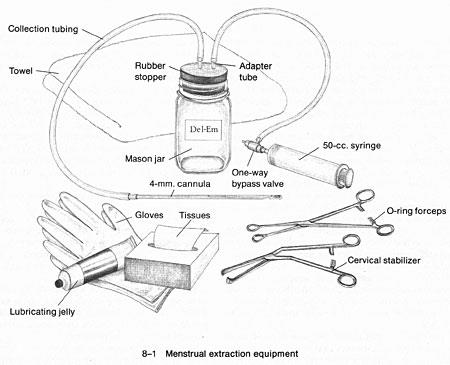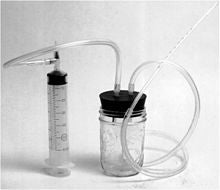On April 7, 1971, two years before Roe v. Wade was introduced, a small group of feminists met at a book store in Los Angeles. Calling themselves the Self-Help Clinic, the meeting’s aim was to educate women about abortion at a time when the procedure was still illegal in 33 states. More specifically, they wanted to teach women how to conduct a vaginal self-exam, and to introduce them to a handheld device they’d recently discovered — one that they hoped would transform women’s access to abortion in the U.S.
The device was created by Harvey Karman, a psychologist who ran a secret abortion clinic on L.A.’s Santa Monica Boulevard. His creation, later dubbed the Karman cannula, was a soft, flexible tube that was used to suction the contents of the uterus out via a small syringe; the invention was actually a refined version of the vacuum aspiration technique, but removed the need for both metal instruments and cervical dilation. The Self-Help Clinic’s founders, including abortion activist Carol Downer, had visited Karman’s clinic and watched him insert an IUD into a woman’s uterus. It was while watching the procedure — and, as she previously wrote, marveling “at how simple and how accessible [the cervix] is with the use of an inexpensive, plastic speculum” — that Downer became convinced that, using Karman’s device, women could learn how to perform abortions themselves.
To encourage the women at the April meeting to get on board with this idea, Downer demonstrated a self-exam on her own vagina. “Upon seeing my cervix, the women’s skepticism about our learning to do abortion vanished,” Downer once recalled, “and by the end of the meeting, we had seen several cervixes and had plans to learn to provide abortions underground.”
It was also during this meeting that Lorraine Rohman, one of the group’s founding members, invented a modification to Karman’s device that would make it easier for non-medical professionals to safely perform abortions up to eight weeks of pregnancy. Rohman added a one-way bypass valve and two lengths of clear plastic tubing, which funneled the contents of the uterus directly into a collection jar — thus allowing for the extraction of more material — and prevented air from entering the uterus, avoiding dangerous perforations. This kit was dubbed the Del-Em kit, and the procedure was called menstrual extraction (ME).


Downer and Rohman traveled across America demonstrating vaginal self-exams and introducing women to the concept of menstrual extraction — they even intended to open an illegal clinic to offer the procedure. However, in 1973, this plan was thwarted by Roe v. Wade — a landmark ruling that made safe, legal abortion a constitutional right. Now, as that ruling is potentially set to be overturned nearly 50 years later, could Downer and Rohman’s DIY technique be set for widespread resurgence?
This week, following a leaked draft that revealed how the Supreme Court had voted to overturn Roe v. Wade — a move that could soon make abortion illegal in several states — talk of abortion alternatives took over. People joked that all men should be forced to have vasectomies (a statement that totally misses the point of bodily autonomy); some women discussed how sterilization is now their top priority; and others emphasized the importance of free, readily available contraceptive options. Some, however, turned to the idea of menstrual extraction. “As an evergreen reminder, menstrual extraction is something many local herbalists know how to do/can teach you to do,” wrote one Twitter user. Another said: “Anyone want to form a menstrual extraction collective?”
Of course, nothing is a suitable alternative for an affordable, accessible and legal abortion — and underground or at-home abortions always carry enormous risks. (According to the World Health Organization, 4.7 to 13.2 percent of global maternal deaths each year can be attributed to unsafe abortions.) But in a world where safe abortions might not be possible, there’s some logic in suggesting menstrual extraction as a legal workaround to potentially forthcoming abortion bans. After all, the technique is specifically named to technically absolve it of any links to abortions — with the word “menstrual” being used because, as Downer told radio station KPCC in 2017, “the procedure was only performed when a woman’s period was due, and they wouldn’t take a pregnancy test beforehand. That way, everybody had plausible deniability.”
The procedure is usually done up to 14 days after the patient’s period should occur, and takes around 20 to 30 minutes. Adhering to its name, menstrual extraction can also be used to free women of a heavy period or help them avoid it completely by enabling them to pass their whole menstrual period at once.
Nevertheless, how medically safe is it to revert back to a method invented almost half a century ago? A 1980 report stated that menstrual extraction is successful 99 percent of the time when performed by a physician on properly selected patients, but there doesn’t seem to be readily available statistics on those procedures performed outside of a medical setting. Unsurprisingly, doctors warn against ME if it’s not done by a medical professional, with one OB/GYN telling Mic in 2016, “This is a serious medical procedure with serious ramifications if not done correctly. Any time you are instrumenting anything into the uterus, you put yourself at risk of perforation, of bleeding and hemorrhage, of infection, of sterility. It’s not something to experiment with. I think the women who say it’s safe to do at home are overstating their capabilities.”
Others — including Downer — disagree. In a 2022 interview with Bitch Media, Downer admitted that complications aren’t unheard of — “not in our group, but in others,” she said — but asserted that “the most unsafe abortion is still safer than being forced to have a child” (unless, of course, it’s one that leads to a maternal death, as mentioned above). A blog post by the Women’s Health Specialists of California also said that menstrual extraction has an “excellent safety record” because of the “rigorous selection process any group doing menstrual extraction follows and the care with which the procedure is carried out.” The procedure is done by a group of people, and, although “the rudimentary aspects” can be learned in a few weeks, the Women’s Health Specialists of California recommended that practitioners take several months to a year to properly learn how to do it.
Along those lines, according to the National Abortion Federation (NAF), menstrual extraction is used today in certain countries “as a crucial strategy to circumvent anti-abortion laws.” In Bangladesh, where abortion has been illegal since 1860, menstrual extraction is legally permitted, and has been since 1979. (ME is known as medical regulation (MR) when it’s medicalized — so, because the procedure is available in Bangladesh and other countries via specific clinics, it’s known as MR in those places.) The procedure is permissable because, as the NAF reports, “it presumably takes place without a technical verification of pregnancy,” therefore it’s not defined as an abortion. The government in Bangladesh allows menstrual regulation procedures up to 10 or 12 weeks after a woman’s last period (depending on the provider).
Menstrual regulation is also a popular procedure in Cuba, where it’s even performed at some walk-in centers. Although abortion has been legal and easy to access in the country since 1979, many women favor MR as a contraceptive method. In fact, according to a 2006 article by IPS News, the rise in women undergoing the procedure led to the country’s abortion rate declining. There are even still groups in the U.S. practicing menstrual extraction today.
But even if abortion is banned in several states across the U.S., there’s still far safer, more regulated options for those seeking a termination — namely, abortion pills. As my colleague Magdalene Taylor wrote earlier this week, “While the future of Roe v. Wade may present a threat to the legal availability of these medications in some states, it won’t stop people from accessing and distributing them through other means. And if abortion does become fully illegal for some, these pills should continue to be their first choice for abortion care.” Frankly, with the current availability of abortion pills, there really shouldn’t be a need for ME at all — it’s merely a radical alternative undergoing new consideration in light of this week’s news.
With that, few would argue that ME should be a go-to option, even in a post-Roe v. Wade world. Still, being knowledgeable about the history of menstrual extraction is a powerful tool, as is joining an ME training group. As Downer herself wrote in 2011: “This is the power of activism on women’s rights — constantly learning, constantly growing and constantly pushing the boundaries of activism in new and creative ways.”

